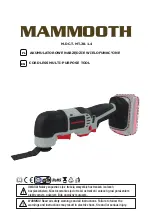
13
EN
3)Personal safety
a) Be careful, watch what you are doing, and use common sense when working
with a power tool. Never use a power tool when you are tired or under the
influence of drugs, alcohol or medicine. One moment of inattention when using
a power tool can result in serious injuries.
b) Wear personal protective clothes, and always wear safety goggles. Wearing
personal protective clothing, such as a dust mask, non-slip safety boots, a hard
hat or hearing protection, depending on the kind or operation of the power tool,
reduces the risk of injuries.
c) Avoid the accidental operation of the power tool. Make sure that the power tool
is turned off, before connecting it to the mains or the rechargeable battery,
picking it up or carrying it. Keeping your finger on the switch, while carrying the
power tool, or if the power tool is set to ON when you connect it to the mains,
can lead to accidents.
d) Remove the setting tools or spanners, before turning the power tool on. A tool
or spanner located in a rotating part can lead to injuries.
e) Avoid an unnatural posture. Make sure you have a safe foothold, and always
maintain your balance. This makes it easier to control the power tool in
unexpected situations.
f) Wear suitable clothing. Do NOT wear wide clothing or jewelry. Keep hair, clothes
and gloves away from moving parts. Loose clothing, jewelry or long hair can
get caught by moving parts.
g) If dust suction and collection devices are mounted, be sure that these are
connected and used properly. Using a dust suction device can reduce risks
related to dust.
4) Operation and handling of the power tool
a) Do not overload the device. Use the proper tool for the type of work to be
performed. When using the suitable power tool, you can work faster and more
safely within the specified power range.
b) Never use a power tool if its switch is defective. A power tool, which cannot be
turned on or off, is dangerous and must be repaired.
c) Unplug the connector from the power outlet and/or remove the rechargeable
battery before performing any settings on the device, changing accessories or
storing the device. These safety precautions prevent the accidental start of the
power tool.
d) Keep unused power tools out of the reach of children. Never allow the device to
be used by people who are not familiar with it or who have not read these
instructions. Power tools are dangerous when they are used by inexperienced
persons.
e) Maintain power tools carefully. Check if the movable parts work perfectly and do
not jam, parts are broken or damaged to such a degree that they affect the
proper functioning of the power tool. Make sure that damaged parts are
repaired before using the device. Many accidents are the result of badly main
tained power tools.
f) Keep cutting tools sharp and clean. Carefully maintained cutting tools with
sharp cutting edges are less prone to jamming and easier to handle.
g) Use the power tool, accessories, insertion tools etc. in accordance with these
instructions. Always take into consideration the working conditions and the task
to be performed. The usage of power tools for other than the designed
purposes can lead to dangerous situations.
5) Operation and handling of the rechargeable device
a) Load the rechargeable battery only in chargers recommended by the
manufacturer. For a charger that is suitable for a given type of rechargeable
battery, there is a risk of fire when it is used with another rechargeable battery.
Содержание M.DC.T.MT.20.1.4
Страница 2: ...2 1 2 3 4 5 8 7 7 6 6 B1 B2 B3 1 2 ...
Страница 3: ...3 B4 2 B4 3 B5 B4 1 ...
Страница 20: ......






































